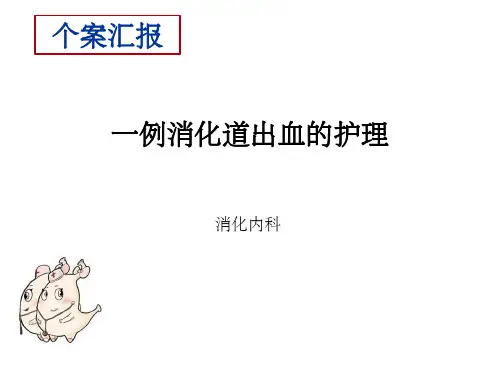一例上消化道出血的护理个案护理
- 格式:ppt
- 大小:628.50 KB
- 文档页数:29
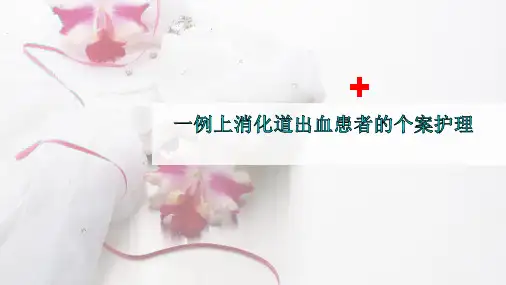

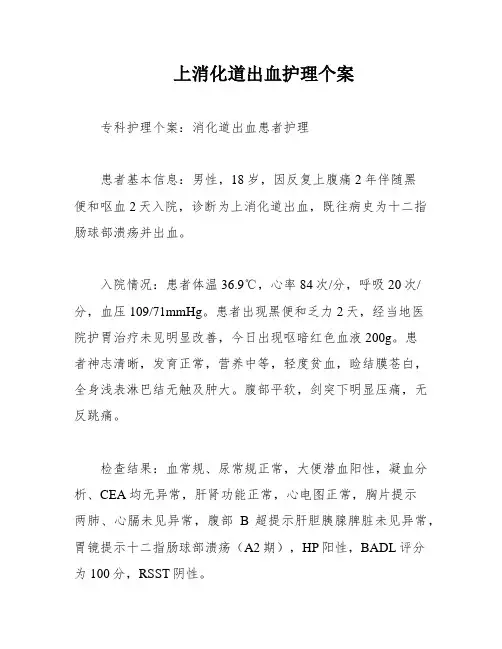
上消化道出血护理个案专科护理个案:消化道出血患者护理患者基本信息:男性,18岁,因反复上腹痛2年伴随黑便和呕血2天入院,诊断为上消化道出血,既往病史为十二指肠球部溃疡并出血。
入院情况:患者体温36.9℃,心率84次/分,呼吸20次/分,血压109/71mmHg。
患者出现黑便和乏力2天,经当地医院护胃治疗未见明显改善,今日出现呕暗红色血液200g。
患者神志清晰,发育正常,营养中等,轻度贫血,睑结膜苍白,全身浅表淋巴结无触及肿大。
腹部平软,剑突下明显压痛,无反跳痛。
检查结果:血常规、尿常规正常,大便潜血阳性,凝血分析、CEA均无异常,肝肾功能正常,心电图正常,胸片提示两肺、心膈未见异常,腹部B超提示肝胆胰腺脾脏未见异常,胃镜提示十二指肠球部溃疡(A2期),HP阳性,BADL评分为100分,RSST阴性。
治疗及护理:入院后,患者接受禁食、埃索美拉唑护胃、能量支持等对症处理,病情稳定。
护理重点包括:1.保证营养摄入:相对卧床休息,平卧位并将双下肢抬高,保证脑部供血。
患者有活动性出血,暂禁食水。
告知患者及家属卧床休息暂禁食的重要性,以取得配合。
及时添加止血药物,观察药物疗效及不良反应。
建立静脉双通道,使用其中一条静脉通道专门执行静脉营养液如脂肪乳、氨基酸等的输注,以保证患者的肠外营养治疗顺利进行。
定期监测患者各项营养状况指标。
2.防止跌倒坠床:准确评估患者现状活动能力,启用跌倒风险护理单。
观察患者有无头晕、心悸、乏力等症状,若上述症状较重,应指导患者绝对卧床休息,床上大小便,防止跌倒。
准确及时地应用各种治疗药物或血液制品,补充血容量,避免贫血加重。
加强巡视,当患者需要帮助时及时提供生活上的照顾。
监测患者的外周血象变化,根据结果指导其活动。
患者于2016年3月16日生命体征平稳,未表现特殊不适,精神状态良好,没有贫血的表现。
大便转为黄色且成形,大便潜血检测结果为阴性。
目前患者病情稳定,接受埃索美拉唑肠溶片、胶体果胶铋胶囊、克拉霉素片和阿莫西林分散片根治幽门螺杆菌的治疗。
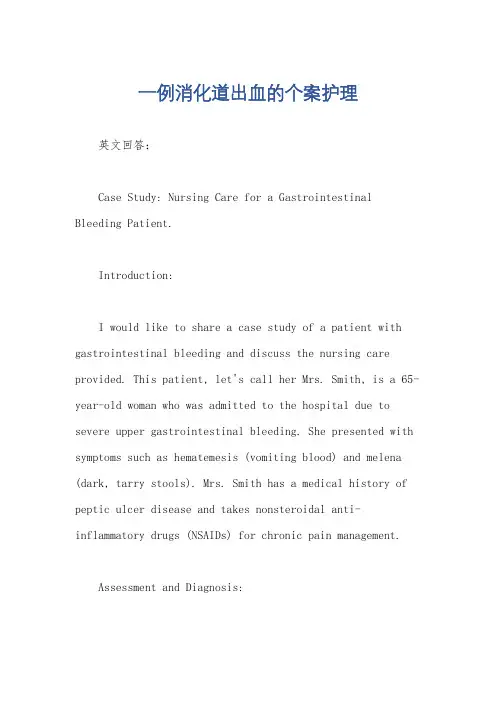
一例消化道出血的个案护理英文回答:Case Study: Nursing Care for a Gastrointestinal Bleeding Patient.Introduction:I would like to share a case study of a patient with gastrointestinal bleeding and discuss the nursing care provided. This patient, let's call her Mrs. Smith, is a 65-year-old woman who was admitted to the hospital due to severe upper gastrointestinal bleeding. She presented with symptoms such as hematemesis (vomiting blood) and melena (dark, tarry stools). Mrs. Smith has a medical history of peptic ulcer disease and takes nonsteroidal anti-inflammatory drugs (NSAIDs) for chronic pain management.Assessment and Diagnosis:Upon admission, I conducted a thorough assessment of Mrs. Smith's vital signs, including blood pressure, heart rate, respiratory rate, and oxygen saturation. I also assessed her level of consciousness and performed a physical examination to check for signs of abdominal pain, tenderness, or distension. Laboratory tests were ordered to determine her hemoglobin and hematocrit levels, as well as coagulation studies to assess her clotting function.Based on the assessment findings, Mrs. Smith was diagnosed with an upper gastrointestinal bleed. The cause was likely the peptic ulcer disease exacerbated by the use of NSAIDs. This diagnosis was confirmed by an esophagogastroduodenoscopy (EGD) procedure, which revealed active bleeding from a gastric ulcer.Nursing Interventions:1. Hemodynamic Monitoring:To ensure Mrs. Smith's stability, I closely monitored her vital signs, especially her blood pressure and heartrate. I also assessed her level of consciousness and urine output to detect any signs of hypovolemic shock. In case of hypotension, I would administer intravenous fluids andblood products as prescribed by the physician.2. Medication Management:Mrs. Smith was started on proton pump inhibitors (PPIs) to reduce gastric acid secretion and promote ulcer healing.I educated her on the importance of taking the medicationas prescribed and advised her to avoid NSAIDs in the future. Additionally, I administered medications to manage her pain and prevent further bleeding, such as histamine-2 receptor antagonists and antacids.3. Blood Transfusion:Due to significant blood loss, Mrs. Smith required a blood transfusion to restore her hemoglobin levels. I ensured the proper identification of blood products, monitored her vital signs during the transfusion, and assessed for any adverse reactions.4. Nutritional Support:As Mrs. Smith was unable to tolerate oral intake due to nausea and vomiting, I initiated enteral nutrition through a nasogastric tube. I monitored her tolerance to the feeding and adjusted the rate and composition of the enteral formula as needed. I also provided her with small, frequent meals once her gastrointestinal bleeding was controlled.5. Emotional Support:I understood that Mrs. Smith might be feeling anxious and scared due to her condition. I provided emotional support by actively listening to her concerns, explaining procedures and treatments in a reassuring manner, and encouraging her to express her feelings. I also involved her family in the care process and ensured they were updated on her condition and progress.Conclusion:In conclusion, caring for a patient with gastrointestinal bleeding requires close monitoring of vital signs, medication management, blood transfusion if necessary, nutritional support, and emotional support. By providing comprehensive and compassionate care, nurses can help patients like Mrs. Smith recover and regain their health.中文回答:个案护理,消化道出血的护理。
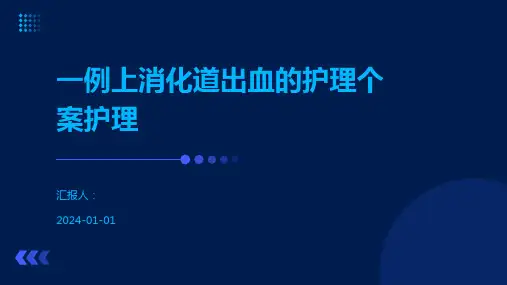


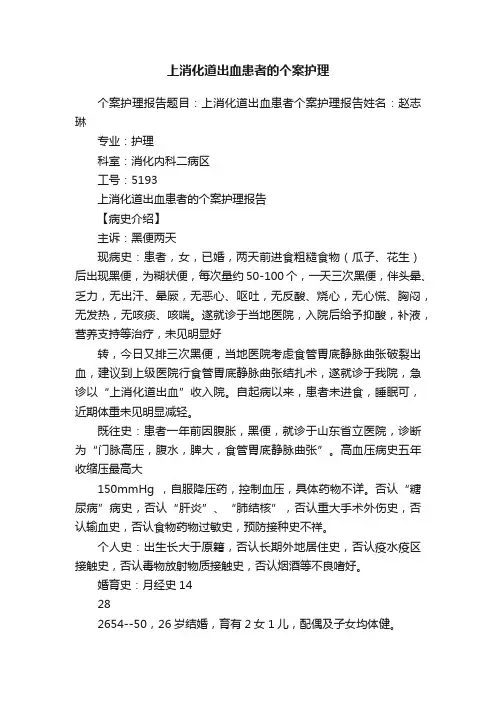
上消化道出血患者的个案护理个案护理报告题目:上消化道出血患者个案护理报告姓名:赵志琳专业:护理科室:消化内科二病区工号:5193上消化道出血患者的个案护理报告【病史介绍】主诉:黑便两天现病史:患者,女,已婚,两天前进食粗糙食物(瓜子、花生)后出现黑便,为糊状便,每次量约50-100个,一天三次黑便,伴头晕、乏力,无出汗、晕厥,无恶心、呕吐,无反酸、烧心,无心慌、胸闷,无发热,无咳痰、咳喘。
遂就诊于当地医院,入院后给予抑酸,补液,营养支持等治疗,未见明显好转,今日又排三次黑便,当地医院考虑食管胃底静脉曲张破裂出血,建议到上级医院行食管胃底静脉曲张结扎术,遂就诊于我院,急诊以“上消化道出血”收入院。
自起病以来,患者未进食,睡眠可,近期体重未见明显减轻。
既往史:患者一年前因腹胀,黑便,就诊于山东省立医院,诊断为“门脉高压,腹水,脾大,食管胃底静脉曲张”。
高血压病史五年收缩压最高大150mmHg ,自服降压药,控制血压,具体药物不详。
否认“糖尿病”病史,否认“肝炎”、“肺结核”,否认重大手术外伤史,否认输血史,否认食物药物过敏史,预防接种史不祥。
个人史:出生长大于原籍,否认长期外地居住史,否认疫水疫区接触史,否认毒物放射物质接触史,否认烟酒等不良嗜好。
婚育史:月经史14282654--50,26岁结婚,育有2女1儿,配偶及子女均体健。
家族史:父母已故,有一姐姐和一妹妹,均体健。
【初步诊断】1、上消化道出血2、门脉高压3、高血压病【治疗方案】1、消化内科护理常规,一级整体护理,禁饮食。
2、完善相关检查:血常规、凝血五项、生化全项等。
3、给予止血,抑酸,降低门静脉压力,营养支持等对症治疗。
【护理诊断】1、潜在并发症:血容量不足。
2、活动无耐力:与失血性周围循环衰竭有关。
3、有受伤的危险:窒息,误吸。
4、营养失调:与禁食、上腹部胀痛不适有关。
5、恐惧:与生命或健康受到威胁有关。
6、知识缺乏:缺乏有关引起上消化道出血的疾病知识。
